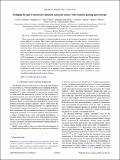Bridging the gap to mesoscale radiation materials science with transient grating spectroscopy
Author(s)
Every, Arthur G.; Dennett, Cody Andrew; Cao, Penghui; Vega-Flick, Alejandro; Ferry, Sara E; Maznev, Alexei; Nelson, Keith Adam; Short, Michael P; ... Show more Show less
DownloadPhysRevB.94.214106.pdf (966.5Kb)
PUBLISHER_CC
Publisher with Creative Commons License
Creative Commons Attribution
Terms of use
Metadata
Show full item recordAbstract
Direct mesoscale measurements of radiation-induced changes in the mechanical properties of bulk materials remain difficult to perform. Most widely used characterization techniques are either macro- or microscale in nature, focusing on overall properties or overly small areas for analysis. Linking the atomic structure of irradiated materials directly with their radiation-affected properties remains one of the largest unmet challenges in radiation materials science. By measuring the change in surface acoustic wave speed as a function of relative orientation on metallic single crystals, we demonstrate that transient grating (TG) spectroscopy experiments have the sensitivity necessary to detect radiation-induced material property changes. We also show that classical molecular dynamics (MD) simulations can be used to accurately simulate orientation-based changes in surface acoustic wave speed in TG experiments, by comparing with experimental measurements and theoretical predictions. The agreement between theory, simulation, and experiment gives confidence in classical MD as a predictive tool to simulate defect-based changes in elastic properties, which cannot yet be fully treated by theory. This ability is of critical importance for the informed use of TG spectroscopy to measure material property changes induced by radiation damage, which may vary by amounts formerly too small for reliable in situ detection. Finally, our MD simulation framework is used to study the effect of an imposed vacancy population on the acoustic response of several materials. The results of these studies indicate that TG experiments are well suited to the ex situ and in situ study of radiation-induced material property changes.
Date issued
2016-12Department
Massachusetts Institute of Technology. Department of Chemistry; Massachusetts Institute of Technology. Department of Nuclear Science and EngineeringJournal
Physical Review B
Publisher
American Physical Society
Citation
Dennett, Cody A. et al. “Bridging the Gap to Mesoscale Radiation Materials Science with Transient Grating Spectroscopy.” Physical Review B 94.21 (2016): n. pag. © 2016 American Physical Society
Version: Final published version
ISSN
2469-9950
2469-9969